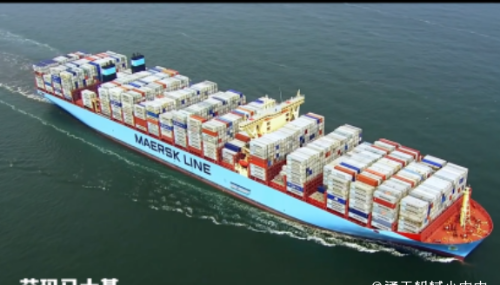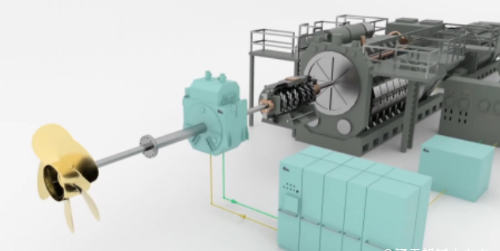With the continuous development and expansion of global trade, the shipping industry has gradually become a very important part of the global economy. In this industry, the presence of large ships is undoubtedly crucial as they can transport large amounts of goods and quickly and safely transfer them to other places. Due to the often large load of these ships, it is necessary to have a powerful transmission shaft to support the torsion of the hull! How long is the transmission shaft of the recently built "Changwei", one of the world's largest container ships with a length of 400m, and what about Rice noodles?
What is the use of large ship transmission shafts?
So let's first talk about how the enormous thrust of a ship's propeller is transmitted to the ship. In fact, the ship's diesel engine drives the propeller to rotate by driving the transmission shaft. The propeller blades provide an axial force during rotation, and the water also produces a reverse force on the propeller blades. This force is the force that drives the ship forward or backward. The thrust of the propeller is transmitted to the intermediate shaft through its tail shaft. The simplest method is to install a thrust bearing on the intermediate shaft that can withstand the axial thrust of the shaft system. Through the thrust bearing, the thrust of the propeller is transmitted to the ship, pushing it forward. From this, it can be seen that the transmission shaft not only plays a huge role in our land transportation, but also in the operation of sea power transportation.
The transmission shaft is one of the main components used to transmit power or torque on ships. It is usually made of steel or aluminum and designed based on the magnitude and form of torque and force.
Simply put, the transmission shaft plays a role in connecting and transmitting force.
The ship moves forward by the rotation of the propeller, and the power of the propeller comes entirely from the engine inside the ship, with the transmission shaft set between the two.
The diesel engine drives the propeller to rotate by driving the transmission shaft, and then the blades form a reverse force in the water, driving the ship forward or backward.
Why are the transmission shafts of large ships designed to be so long? Doesn't it affect the ship
The length and shape of the transmission shaft may vary depending on the type and design of the ship. Taking the Emma Maersk container ship as an example, with a total length of 397 meters, its optical transmission shaft is over 100 meters long.

In large container ships, a transmission shaft may have a length exceeding several tens of meters and bear enormous forces. Therefore, the transmission shaft must undergo precise calculation and design to ensure that it can withstand various twists and forces on the hull, while also taking into account the weight and size of the shaft.
In the design of large ships, the transmission shaft is usually connected to the propeller and extends backwards through the underwater stern frame and stern tube. Therefore, while ensuring the strength of the transmission shaft, it is also necessary to consider the length and diameter of the transmission shaft to ensure that it can adapt to the design and operational requirements of the ship. If the length of the transmission shaft is too long, it will cause distortion and distortion when transmitting power, which will affect the stability and operational performance of the ship. At the same time, if the diameter of the transmission shaft is not large enough, it is easy to cause stress concentration and cause damage or fracture to the transmission shaft. Therefore, ship manufacturers must carefully calculate and select the length and diameter of the transmission shaft to ensure its reliability and durability.
The transmission shaft of ships is generally longer, because the larger the ship, the greater the torque the transmission shaft receives during startup and shutdown. By making the transmission shaft long and connecting multiple sections through a high elastic coupling, the elastic deformation of the transmission shaft during the start stop process can be compensated to the maximum extent, avoiding plastic deformation or fracture of the shaft due to excessive torque. But don't assume that long and thick transmission shafts have no impact on ships, as the impact is actually very significant. It can be divided into the following points.
1. Cost increase. The long and thick transmission shaft incurs significant expenses in terms of material costs, processing costs, and transportation and installation costs.
2. It has a significant impact on the entire shaft system. The longer and thicker the transmission shaft, the more intermediate bearings it requires, and the larger the area of the bearing pads, resulting in greater friction and greater friction loss of the entire shaft system.
3. Impact on the economy. The longer the transmission shaft of a ship, the more space it occupies, especially for mid or mid tail models. Special shaft tunnels are also needed to ensure the passage of the transmission shaft, which means occupying the ship's space, reducing the ship's cargo capacity, and reducing economic efficiency.
For the ship's transmission shaft we mentioned at the beginning, it not only needs to transmit the huge torque of the main engine to the propeller, but also needs to transmit the huge thrust or tension of the propeller to the ship. Therefore, the ship's transmission shaft will also be subjected to compressive and tensile stresses. It is precisely because of compressive or tensile stresses that most of the ship's transmission shafts are solid. Of course, they can also be made hollow, but their effect is not as good as solid shafts. This is exactly the opposite of the situation where the shafts we use in daily life are mostly hollow, as mentioned before.

Sealing technology is also crucial when installing the transmission shaft
In large ships, especially in areas involving the installation of transmission shafts such as the stern frame and stern tube, sealing technology is also crucial. In order to prevent water from entering the stern of the ship, maintain pressure balance, and secure core components such as the transmission shaft and propeller, ship manufacturers need to take a series of measures. Firstly, tail bearings are installed inside the stern frame and stern tube to support the weight of the transmission shaft and propeller, and friction is reduced through oil lubrication. At the same time, the sealing device above the stern tube ensures that water flow does not flow into the interior of the ship along the transmission shaft. To ensure sealing performance, these sealing devices typically consist of multiple components, such as pipelines, sealing rings, etc., which require regular inspection and replacement.
In addition, with the development of technology, modern ships are often equipped with various high-tech instruments and equipment. For example, some advanced ships use laser scanning technology to inspect the stern tube to ensure its quality and operational status. Similarly, in the design and manufacturing process of the transmission shaft, technical means such as computer simulation and material science can also be used to improve the strength and reliability of the transmission shaft. The application of these technologies can not only improve the operational performance and safety of ships, but also reduce the cost of ship maintenance and reduce the impact on the environment.
The transmission shaft is a very important component in large ships, which carries the power and torque of the ship and ensures its normal operation. In the design and selection process of the transmission shaft, multiple factors need to be comprehensively considered to determine the optimal length and diameter. At the same time, sealing technology is also essential in the design and manufacturing of the stern tube, especially to prevent water from entering the interior of the ship and ensure the safety and stability of core components such as the transmission shaft and propeller. With the continuous development and progress of technology, it is believed that in the future, ship technology and equipment will become increasingly advanced, better able to meet people's growing needs and challenges.
Recently, the "Changwei" vessel, one of the 10 newly built 24000 TEU class ultra large container ships by China Evergreen Shipping, made its maiden voyage. This ship, with a length of 400 meters and a width of 62 meters, is currently one of the largest container ships in the world.
For such a huge ship, the length of the transmission shaft is also an important issue. According to the classification, the transmission shaft belongs to a shaft that only receives or mainly receives torque. In car transmission shafts, we often see transmission shafts with wheels and transmissions connected at both ends. In large ships, the length of the transmission shaft is even more astonishing.

Specifically, the transmission shaft in large ships is actually the stern tube. The tail shaft tube is a complete device composed of the tail shaft tube, tail bearing, sealing device, lubrication and cooling system. Its function is to separate the stern peak and stern shaft of the ship, and install stern bearings internally to support the stern shaft and propeller. For such a large ship with a length of nearly 400 meters, the length of the transmission shaft will also be very long, and the specific amount needs to refer to the ship's design drawings.
With the continuous development of modern technology, the sealing problem of large ships has been well solved. According to the explanation, the tail shaft tube device needs to achieve sealing between the tail shaft and the tail shaft tube. The specific method is to install sealing components on the tail shaft pipe, such as metal corrugated pipe seals, rubber sealing rings, cement rings, etc. At the same time, it is also necessary to ensure the normal operation of the stern tube through lubrication and cooling systems, in order to ensure the navigation safety of the entire hull.
In short, in terms of sealing, modern technology can already solve this problem well, and the lubrication and cooling systems of ships can also maintain the normal operation of the stern tube. Of course, with the continuous innovation of technology, the transmission shafts and sealing schemes of large ships in the future will continue to be optimized and improved.









